 |
|---|
Please note the following is catered specifically to Gameboy/Gameboy Color releases in the EUR PAL region. Though there will be some similarities to other regions, there are also significant differences – the largest being for example, the absence of a mid-alignment tray in the NTSC market.
Understanding trays
Practices
It should be stressed that manufacturing processes by Nintendo were not airtight, and outright messy in some instances – there are plenty of inconsistencies in their practices for which insert/ad flyer would be included (if at all), or which tray was used, and so some leniency should be given when assessing if a particular insert came with your game.
Completeness
It is also up to the individual to decide if they opt to include specific inserts into their own games for completeness. For example, both a dust protector and a cartridge bag were alternated between releases/reprints, with no discernible pattern. Games like Tetris also had extensive print runs and releases with both Blister packs and Bottom-alignment trays.
Tray types
Throughout the Gameboy and Gameboy Color lifespans, there have been several variations of insert tray methods used. The following are the known trays to exist for PAL:
Blister packs
- A plastic transparent thin tray, with a slot for cartridges in its centre, and two grooves on either side so that the cartridge may be scooped out easily.
- These were used mostly for early Gameboy titles: think Tetris, Link’s Awakening (not DX), Wario Land 1, etc. Very emblematic of their times, these were used dominantly for several years throughout the Original Gameboy’s lifespan.
- It is a cheaper form of package manufacturing compared to its cardboard counterpart.
- These should be very rarely seen with GB titles by the end of its run in 1998.
- These do not appear to be used for GBC titles (with the exception of Japanese region games).
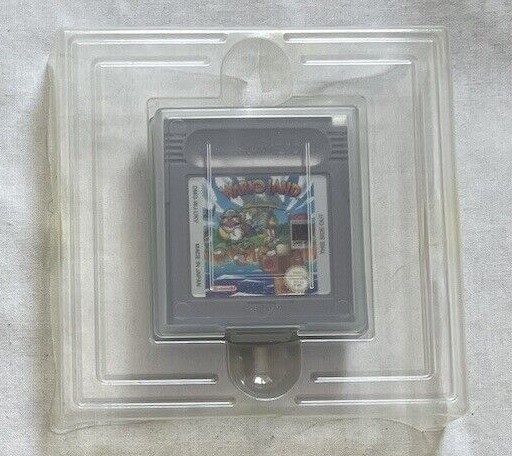 |
|---|
Bottom-alignment tray inserts
- White and made of cardboard with minimal glossing. The slot for the cartridge is in the bottom (or top if you are feeling inclined).
- These were used for titles between both the GB and GBC, and eventually took over from the blister packs as the primary standard insert tray.
- Many titles initially released with a blister pack that had massive print runs, such as Tetris, would transition to using these.
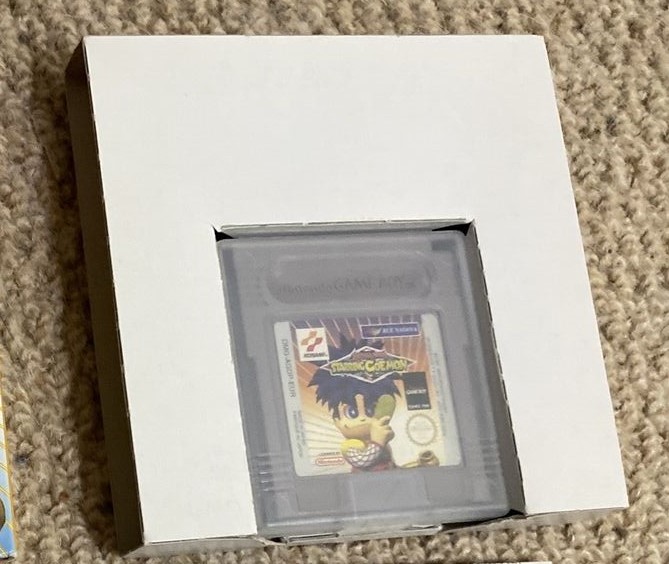 |
|---|
Branded Bottom-alignment tray inserts
- The same as standard Bottom-alignment trays, but manufacturing would imprint numbers and serial codes (CGB for the GBC) into the tray.
- This practice started during the GBC’s life.
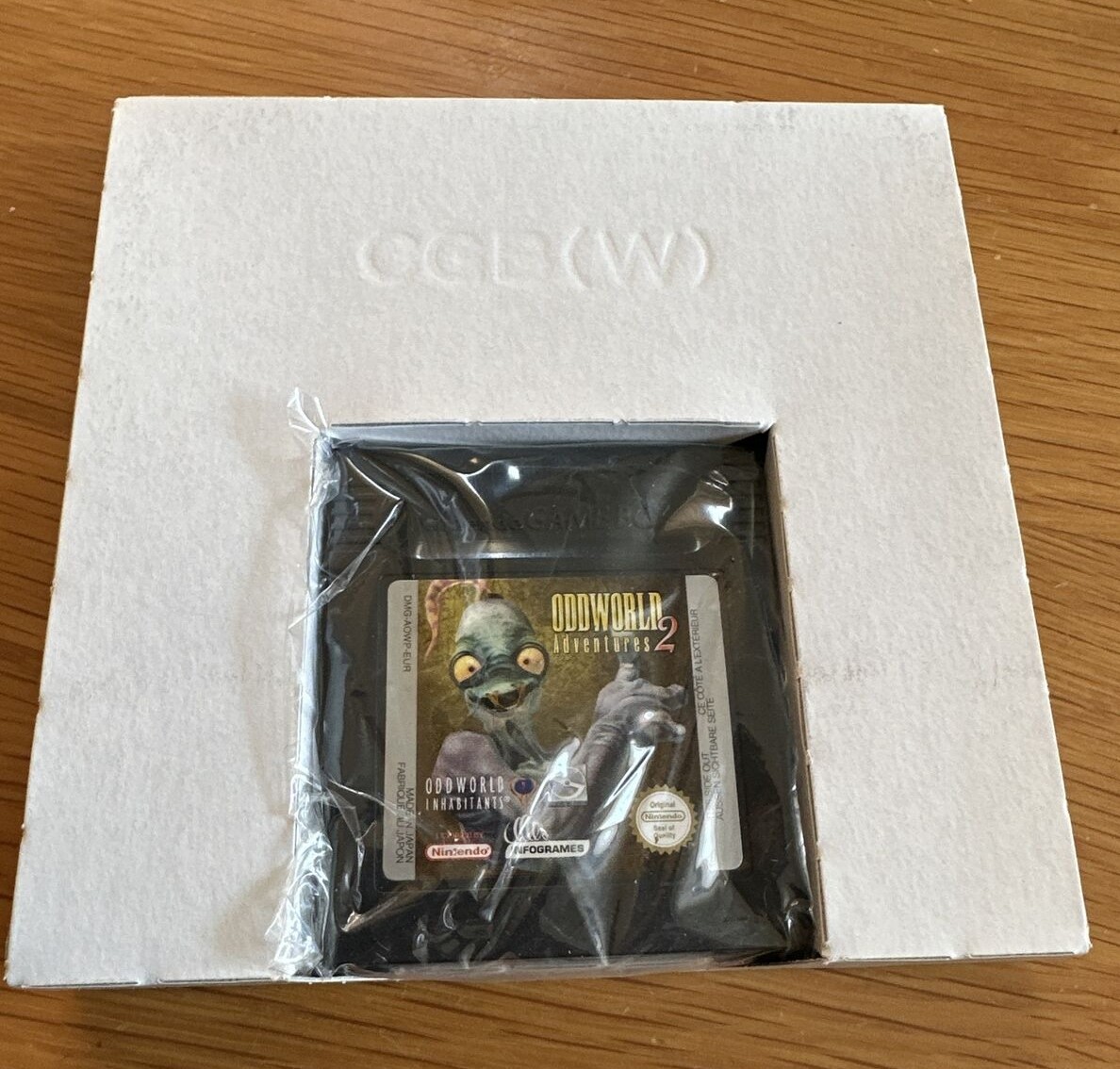 |
|---|
Mid-alignment tray inserts
- White and made of cardboard, these are like Bottom-alignment tray inserts, except their slot is in the centre, and there are two crevices situated to its sides.
- These were introduced alongside the Gameboy Color and were used concurrently with Bottom-aligned trays for its titles up until the conclusion of the Gameboy Color’s life.
- For the Original Gameboy, these trays were exclusive to Gen 1 Pokemon titles.
 |
|---|
Inner moulded slot
- Some titles, or even reprints of later titles that originally used separatable trays, would instead incorporate a cheaper method of manufacturing by having moulded pieces of cardboard that were hard-fitted into the internals of the Game Box.
- Suffice to say these are not removable, nor should they attempt to be removed!
- In PAL regions, these appear to have started with Gameboy Color titles, but in overseas territories such as NTSC, they were present on Gameboy titles as well.
 |
|---|
Solid White blister pack
- The most uncommon of trays, and similar to the transparent blister packs mentioned above, these are also made of plastic, but come in a solid white colour.
- They are seen with particular titles on both the GB and GBC, such as Oddworld Adventures and Turok respectively.
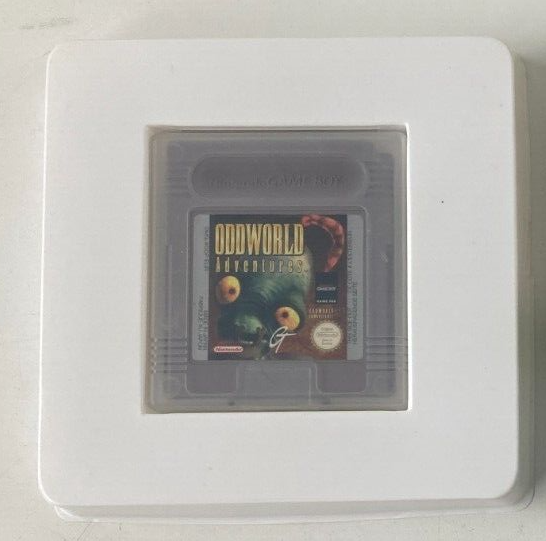 |
|---|
Hollow Mid-alignment
- I am uncertain as to if this is an official insert, as I have only seen it with non-English PAL releases, and exceedingly rarely at that, but I will include here for brevity.
Legit tray + title combos
The key to determining which is a ‘legit’ tray + title combo appears to be in the publication house. Being mindful again that practices were not always consistent, there are some general principles that can be observed:
- ‘Japanese’ publishers tend to opt for Bottom-alignment over blister packs.
- With the exception of releases in its own territory!
- Or if it lacks a release in its own territory entirely but publishes in NA/EU!
- Or for extremely early titles in 89 and the early 90s, where blister packs were simply prevalent across most titles regardless of publisher!
- Western publications tend to use blister packs more liberally.
- Mid-alignments are dominant in titles where Nintendo is the sole publisher across all regions of release.
- Not just Pokemon, but Mario titles (Tennis, Wario, Donkey Kong, etc.), or anything that Nintendo themselves publish exclusively such as Disney tie-ins like Beauty and the Beast: A Board Game Adventure for GBC, all tend to use mid-alignment trays.
- Titles where Nintendo was a partial publisher won’t follow this trend. For example, Nintendo was responsible for publishing Shadowgate Classic in NA and EU territories, but Kemco was the publisher in the JP region. This title uses a Bottom-aligned tray for both western releases rather than mid-aligned, and a blister pack for its Japanese release.
- NTSC markets seem to use the Inner moulded slot in cases where PAL would have otherwise used Mid-alignment, but this requires further investigation and samples as the current observation may be subject to sample bias. YMMV!
Verification methods
So now that you have a rough idea as to which inserts go with which games, how do you tell if your tray is legit?
Typically, bootleggers do not concern themselves with replicating trays. Instead, trays are openly advertised and sold as ‘reproduction’ or ‘replacement’ trays across a multitude of market places and often seen in a better light than their cartridge/box counterparts which are usually more nefarious in nature - the objective of carts and boxes is to convince unsuspecting buyers that they are genuine, whereas tray replacements are typically seen to help provide structure to existing boxes rather than for ‘profit-making’.
As such, trays are not strictly made to emulate originals in every respect. At a top-level glance they look the same but with close examination, you should be able to identify quite quickly if your tray is an original.
More research will need to be done on the other inserts. The following is specifically on verifying the legitimacy of Mid-alignment trays, which were included for the most common games purchased on the Gameboy in PAL territories: Nintendo titles from the Pokemon and Mario franchises.
Mid-alignment tray verification criteria
- The trimming of the hinges and joints will usually be different patterns. Original trays will use shorter dotted patterns at the lower level within the crevice openings, medium length at the upper level in the crevice openings, and long trims in the upper level of the cart slot area.
- Original trays will not have any trimming at the top of the inner slot of the tray. Some repros will have centimetre-length trims here, but this is not reliable as some reproduction trays will omit a majority of trims entirely, and by coincidence, miss this one out.
- The surface area of the board is mostly non-reflective, and should not be glossy. However, glossiness (or a lack thereof) is NOT a verification method; good reproductions have been created that have exceptionally well done surface areas that are almost 1-to-1 to originals. That said, originals are not entirely matte, and will have some very slight reflective properties, usually subtle ‘streaks’ of light that can be observed on the board under the right lighting.
- On the rear side of the tray is a gap where the surface area of the board wraps around; originals should be barely a millimetre apart, but reproductions will usually not get this length exactly and end up with double this at around a 2mm width.
- The opening to the side of the horizontal strip should be roughly 21mm in height, and align with the square holes in the rear of the tray.
- The internal cardboard, the ‘grey’ part will be pale on an original tray. Repros tend to over-saturate here, almost reaching a ‘yellow’ colour.
- Numbers imprinted on the back are not a verification method - originals both with and without numbers exist!
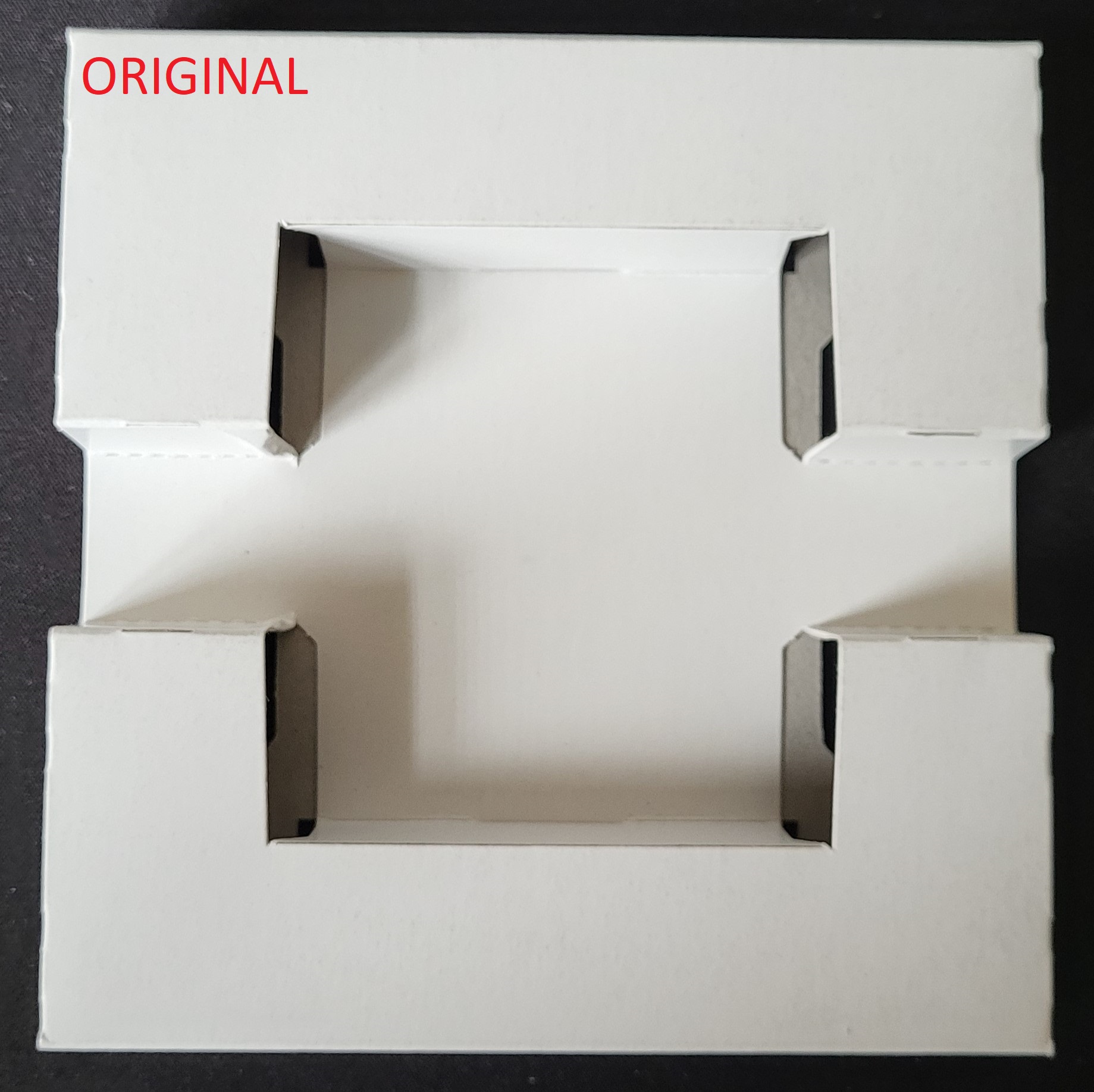 |
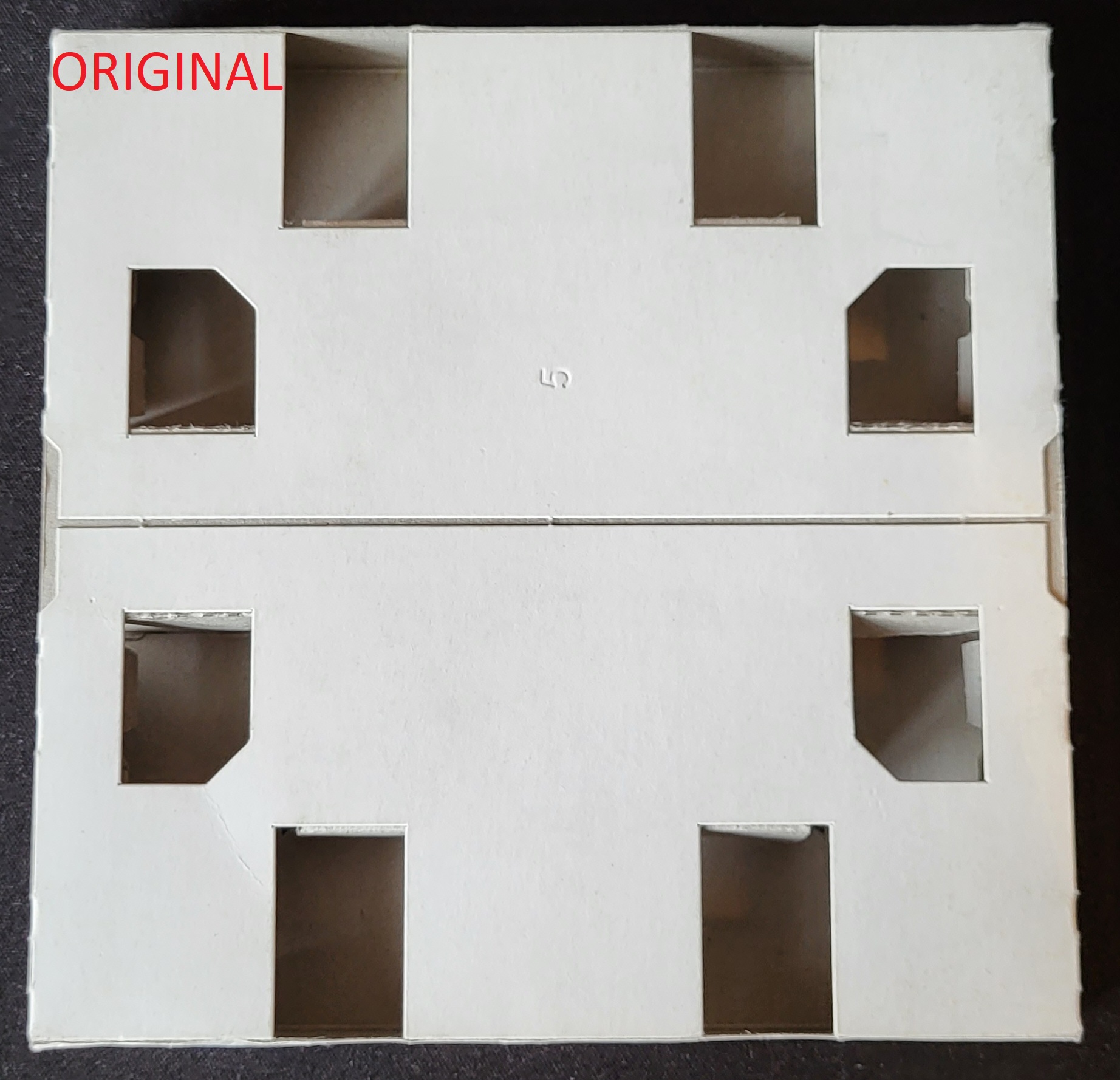 |
|---|
Of particular note are the trimmings – these are distinct, and so far have not been completely replicated elsewhere. The following picture is the same as the above, but with annotated drawings to show where to expect the trimmings of an original tray:
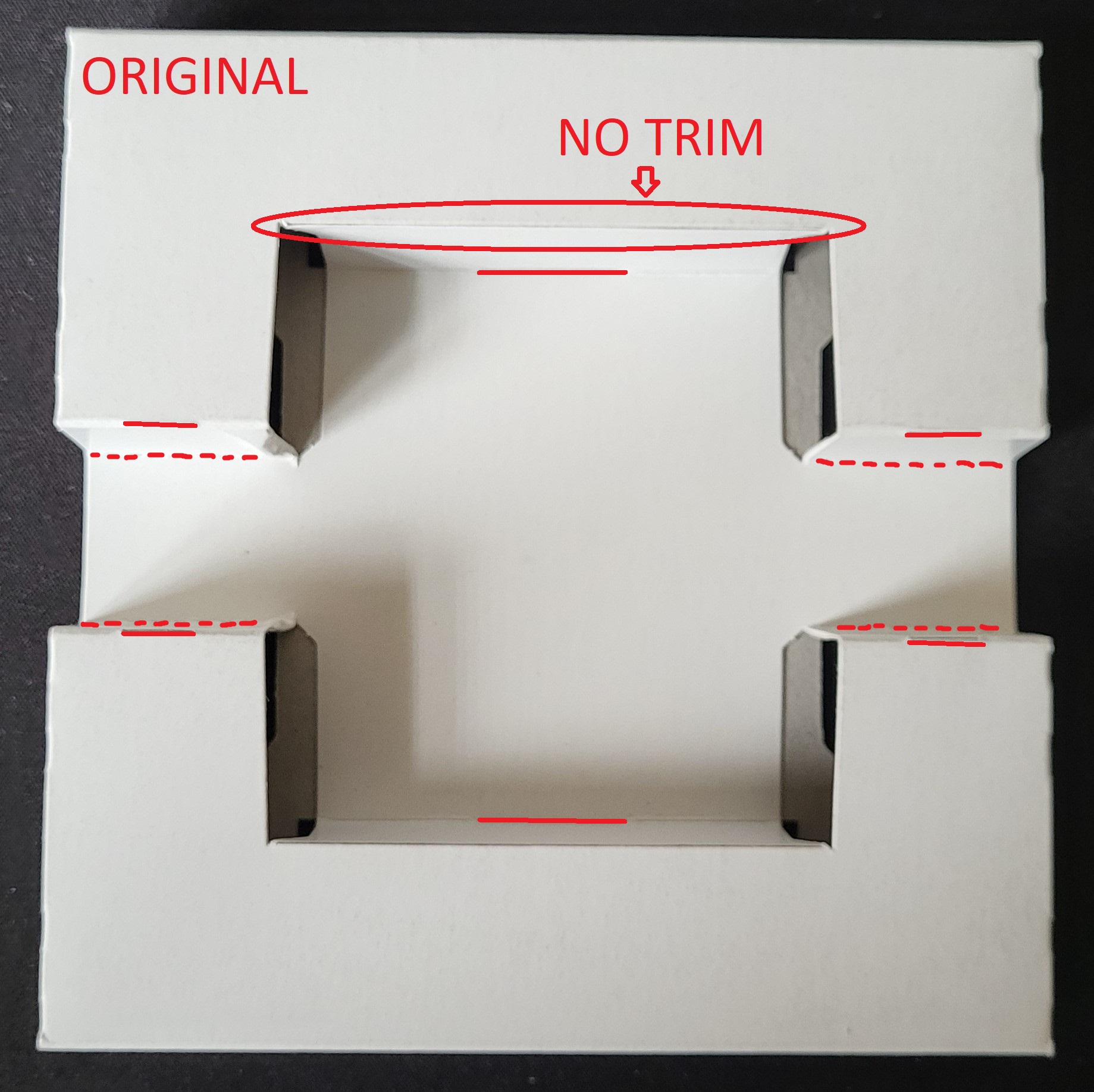 |
|---|
Note the absence of trim on the upper level of the centre edge; some reproduction trays may insert a trim here but an original should only have a single long trim on the lower level, a medium trim on the upper level of the crevice, and short dotted trims on the lower level of the crevice:
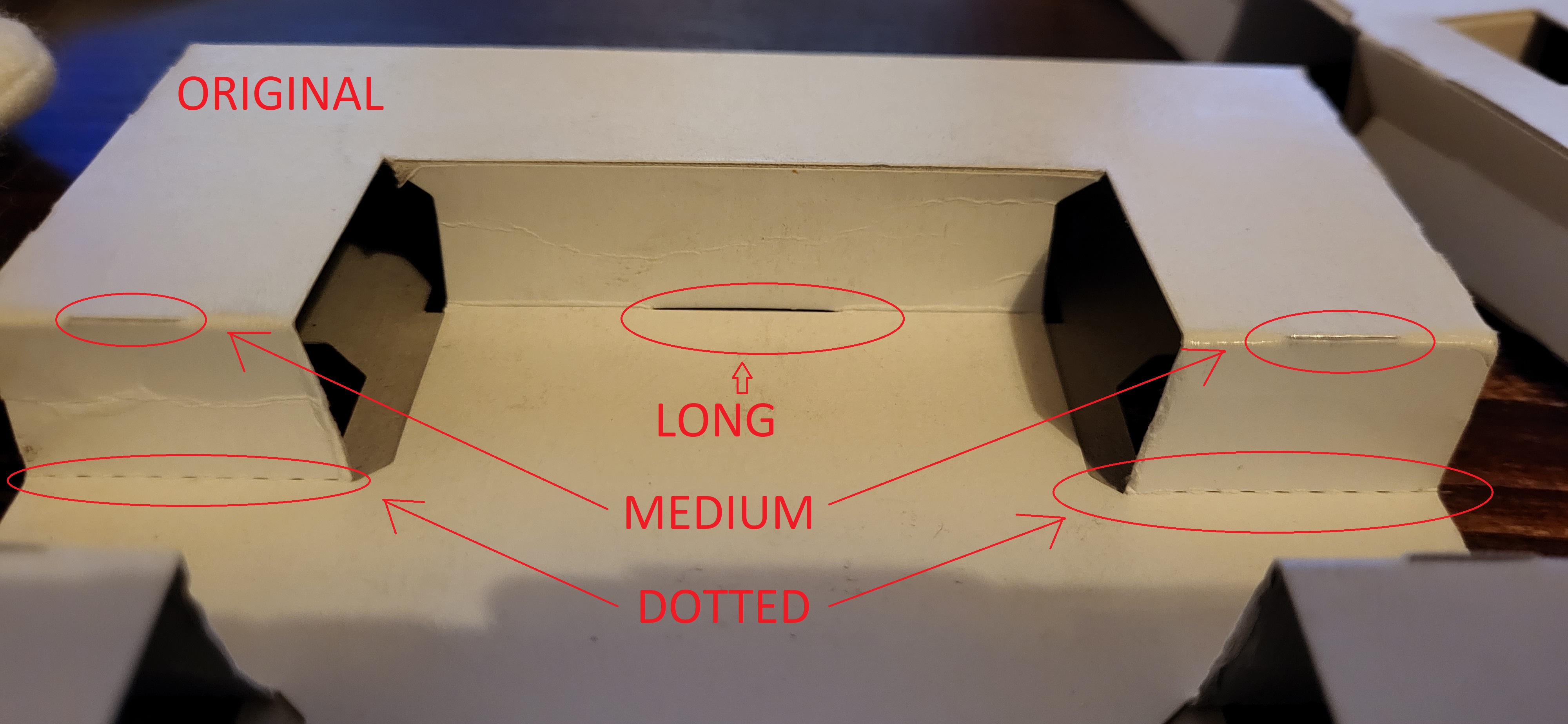 |
|---|
Compare to this replacement tray, which is as of writing the closest match I have been able to source:
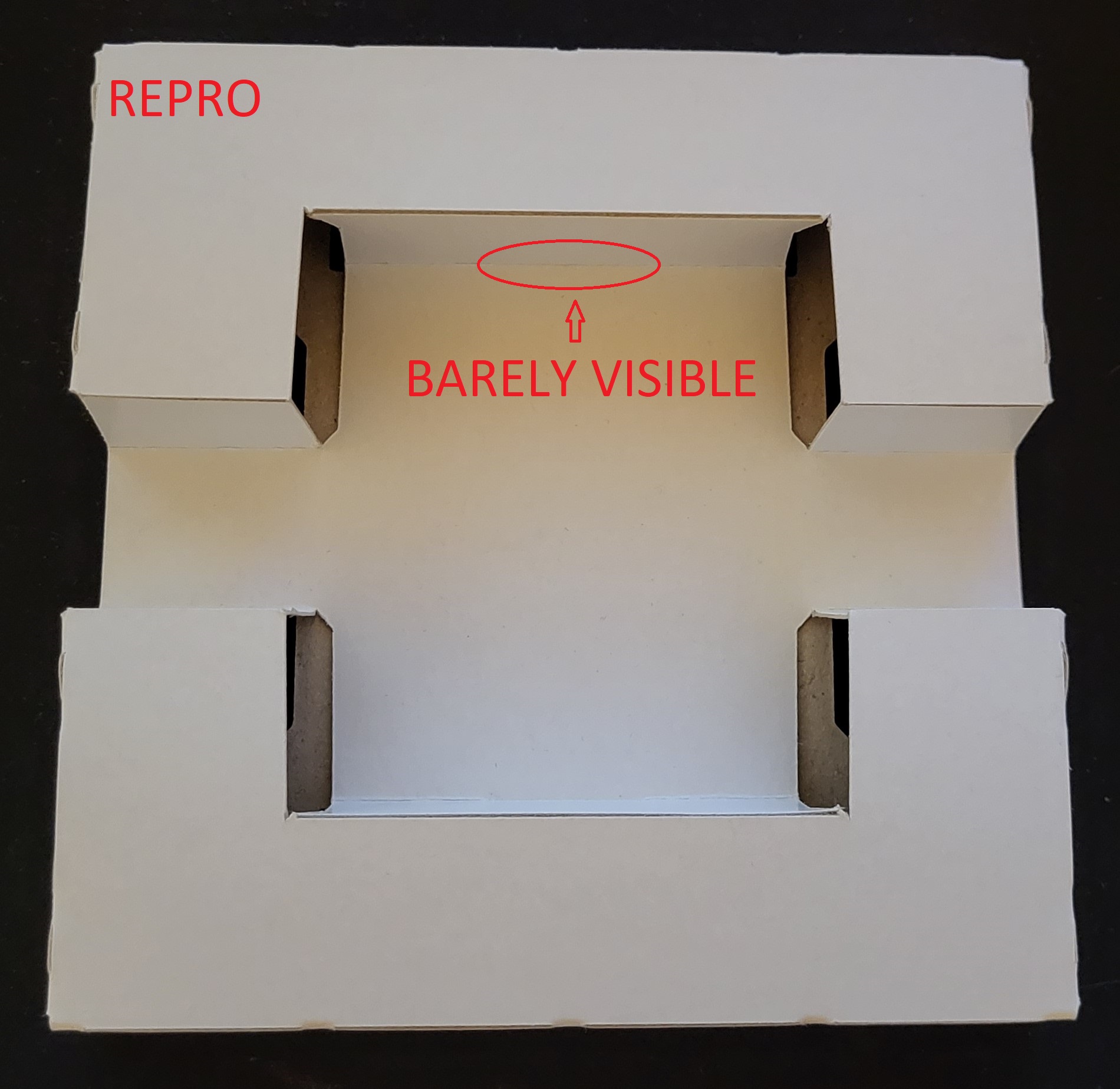 |
|---|
Minimal/no trimmings, except a single, barely noticeable long trim in the lower centre. Original trays should have a clearly visible trim, usually even at a distance the long one in the lower level centre should be visible.
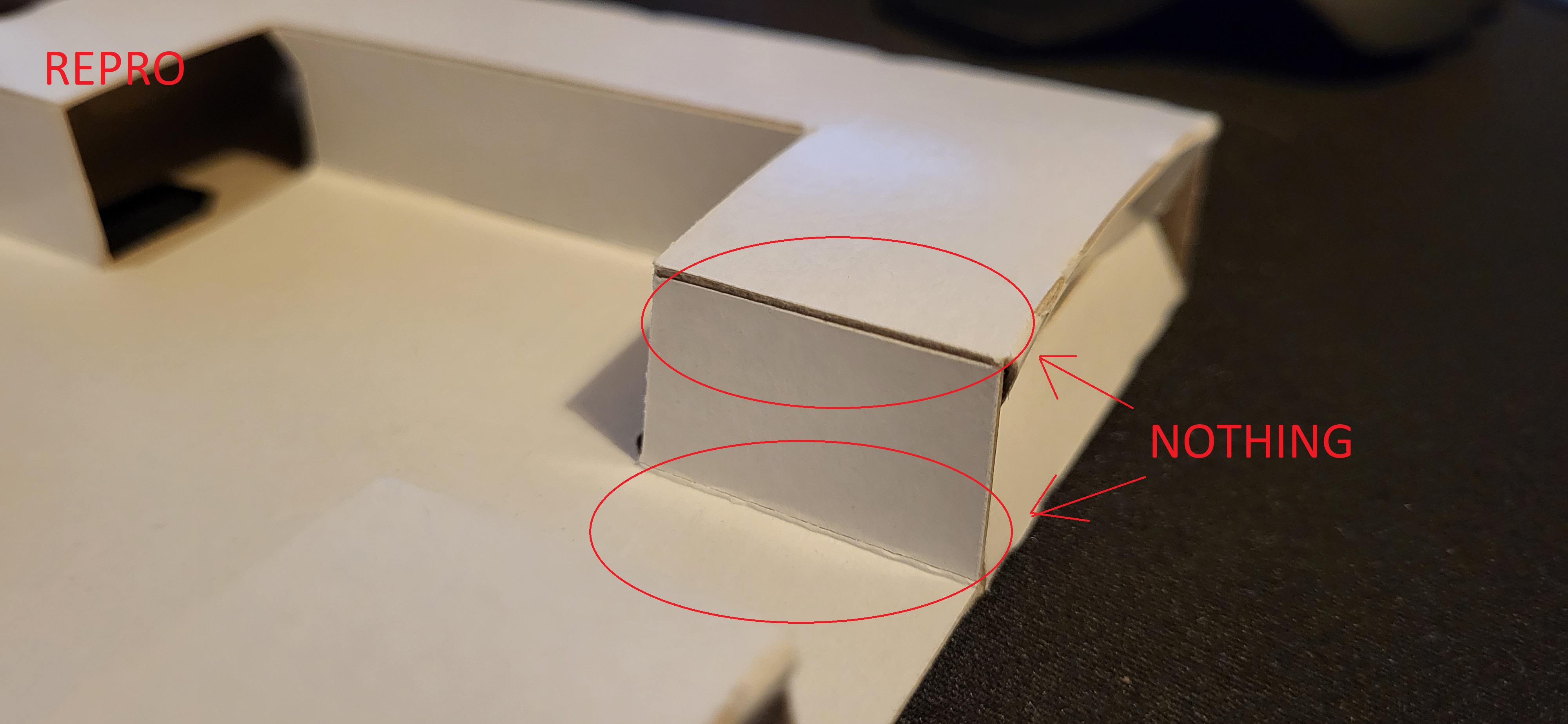 |
|---|
Look for a paler grey on the original trays for its ‘internal’ cardboard, it should not be a warmer shade, like brown/yellow, but a firm grey. Always be mindful of sun damage however! Why you would put a tray in the sun is beyond me, but I have seen several retro items with considerable sun damage so don’t rule it out!
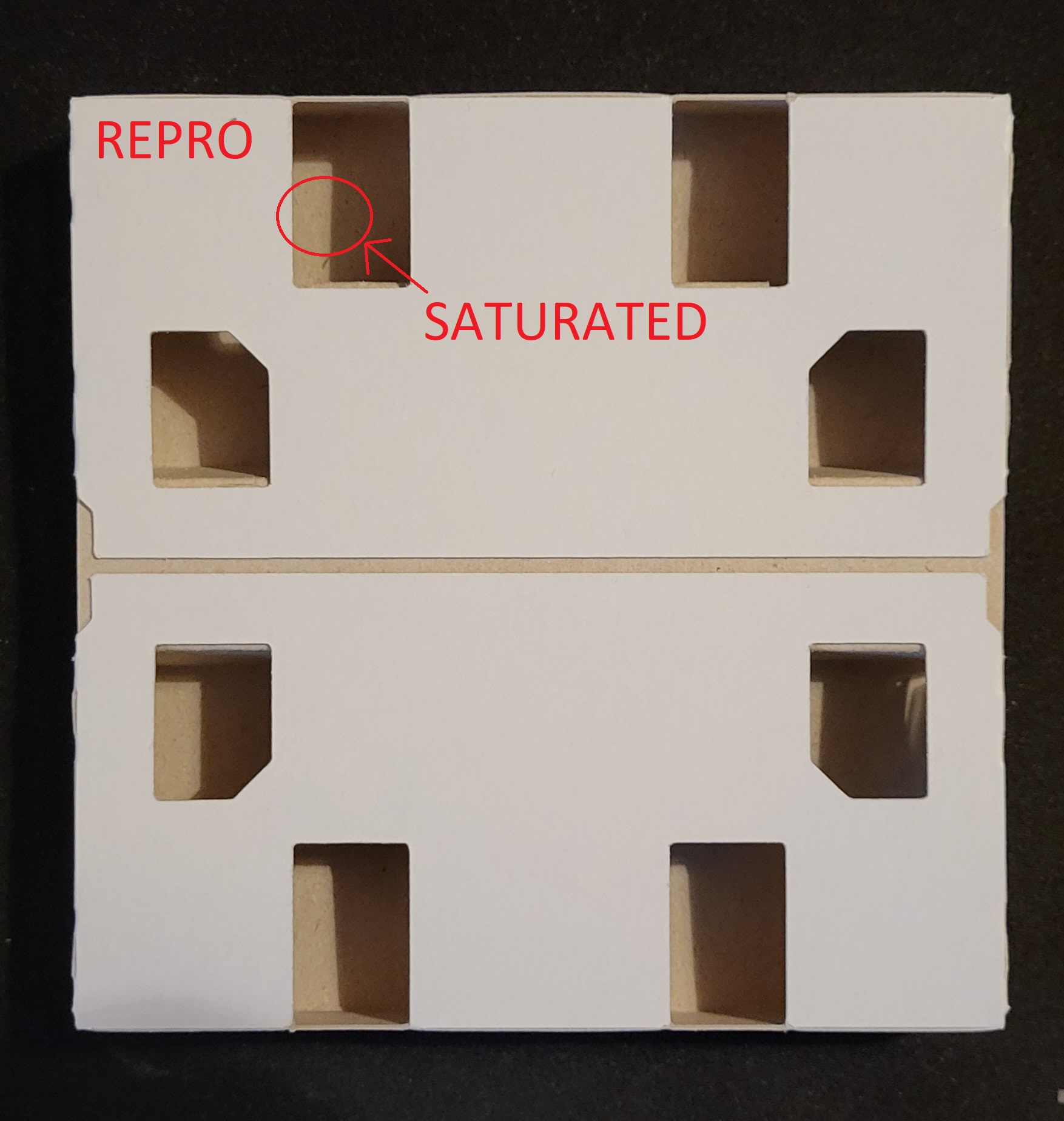 |
|---|
The gap of the thin horizontal strip should barely be about a single millimetre in length. The opening from that strip to the edge of the board also varies a few mm across some originals; it should be around 21mm and should align with the square holes in the back of the tray:
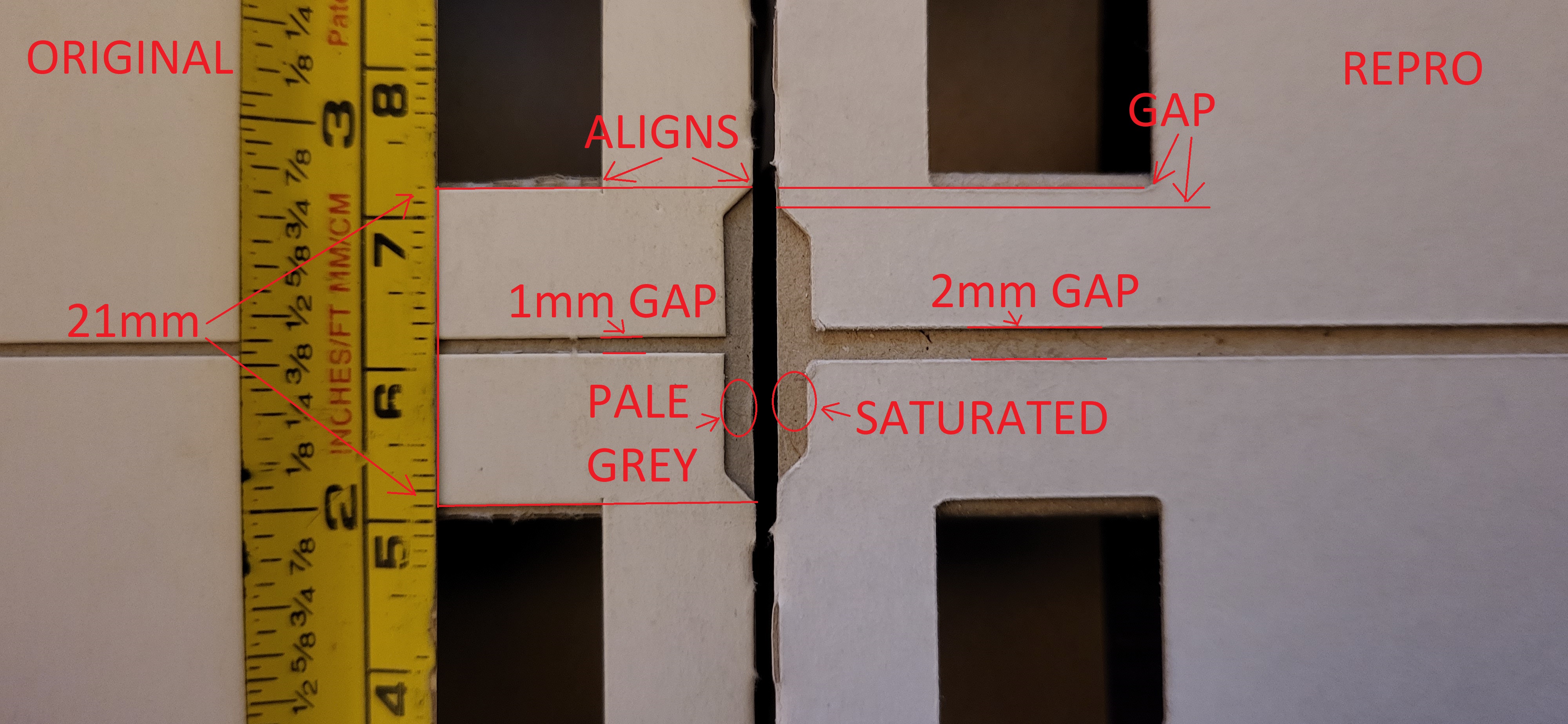 |
|---|
Final thoughts
- This area of study is very esoteric, and can be difficult to verify with regards to legit tray + title combos. Unless we start seeing people open their sealed copies (we won't), most of the analysis here will have to come down to consensus and analysis of sold copies / existing open collections / memory.
- Whilst studying manufacturing principles, I am reminded of early MTG edition production; very wishy-washy and organically developed!
- No single criterion should be used as a verification or de-verification method; always take a tray in its entirety!
- It is EXTREMELY uncommon for genuine trays to be sold separately. More often than not the only way to source these is to buy them as part of an original boxed game.
Credits
- Written by Harkren